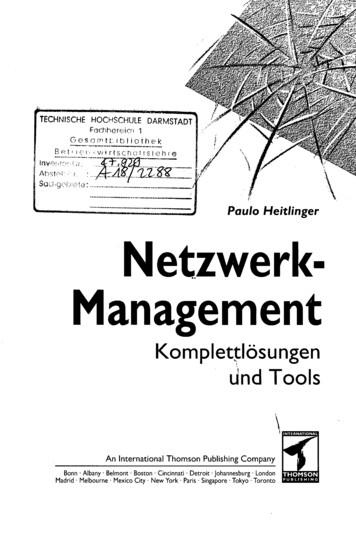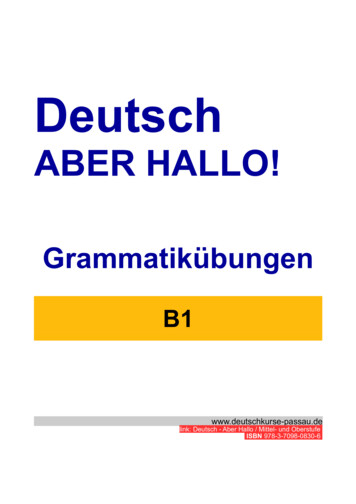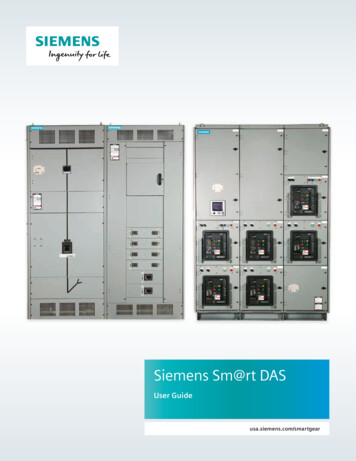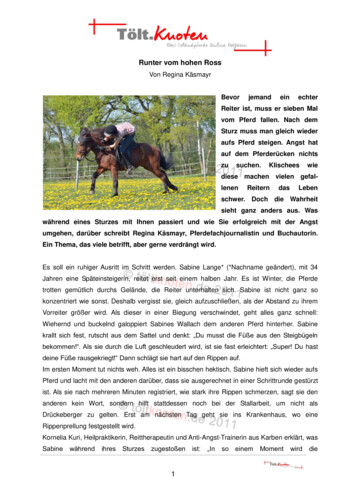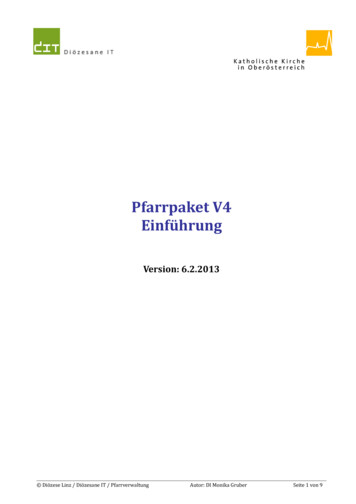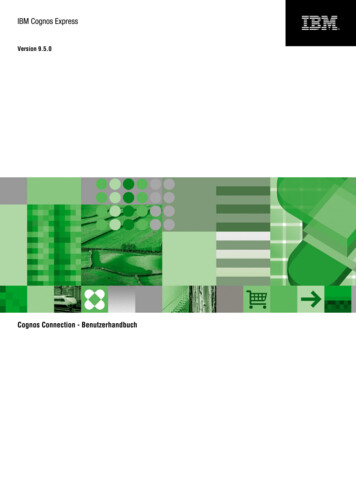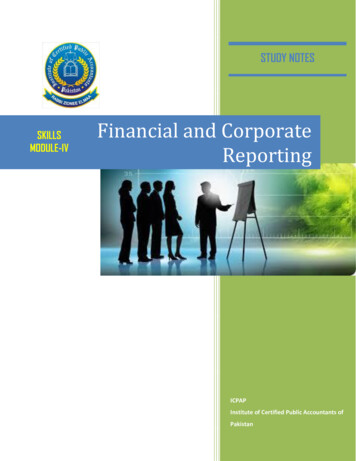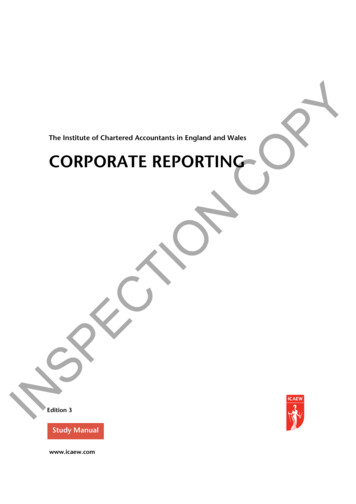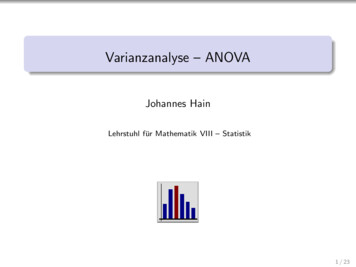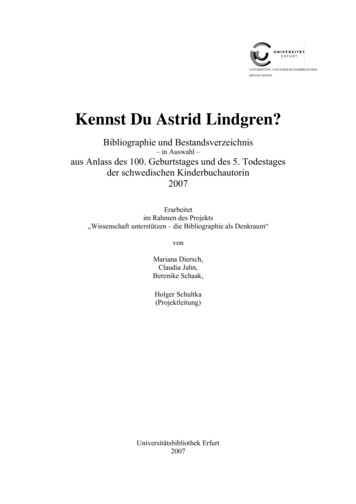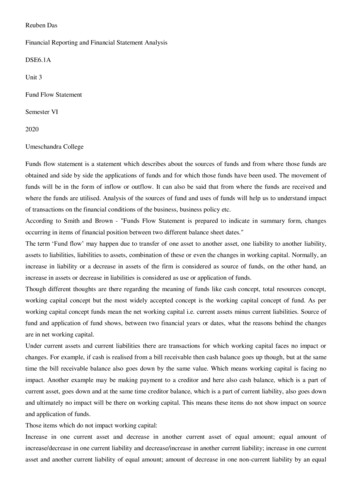
Transcription
Reuben DasFinancial Reporting and Financial Statement AnalysisDSE6.1AUnit 3Fund Flow StatementSemester VI2020Umeschandra CollegeFunds flow statement is a statement which describes about the sources of funds and from where those funds areobtained and side by side the applications of funds and for which those funds have been used. The movement offunds will be in the form of inflow or outflow. It can also be said that from where the funds are received andwhere the funds are utilised. Analysis of the sources of fund and uses of funds will help us to understand impactof transactions on the financial conditions of the business, business policy etc.According to Smith and Brown - "Funds Flow Statement is prepared to indicate in summary form, changesoccurring in items of financial position between two different balance sheet dates."The term ‘Fund flow’ may happen due to transfer of one asset to another asset, one liability to another liability,assets to liabilities, liabilities to assets, combination of these or even the changes in working capital. Normally, anincrease in liability or a decrease in assets of the firm is considered as source of funds, on the other hand, anincrease in assets or decrease in liabilities is considered as use or application of funds.Though different thoughts are there regarding the meaning of funds like cash concept, total resources concept,working capital concept but the most widely accepted concept is the working capital concept of fund. As perworking capital concept funds mean the net working capital i.e. current assets minus current liabilities. Source offund and application of fund shows, between two financial years or dates, what the reasons behind the changesare in net working capital.Under current assets and current liabilities there are transactions for which working capital faces no impact orchanges. For example, if cash is realised from a bill receivable then cash balance goes up though, but at the sametime the bill receivable balance also goes down by the same value. Which means working capital is facing noimpact. Another example may be making payment to a creditor and here also cash balance, which is a part ofcurrent asset, goes down and at the same time creditor balance, which is a part of current liability, also goes downand ultimately no impact will be there on working capital. This means these items do not show impact on sourceand application of funds.Those items which do not impact working capital:Increase in one current asset and decrease in another current asset of equal amount; equal amount ofincrease/decrease in one current liability and decrease/increase in another current liability; increase in one currentasset and another current liability of equal amount; amount of decrease in one non-current liability by an equal
amount of increase in other non-current liability; decrease in one current asset and one current liability of equalamount; increase in one non-current asset and one non-current liability of equal amount.Some examples of these are payment made to creditor; received from debtor; converting one fixed asset intoanother fixed asset; conversion of debenture into share; purchase of stock or sale of stock in cash or credit etc.Those items which do impact working capital:Sale of fixed asset; issue of shares and debentures; redemption of share or debenture; sale of non-current asset;fixed asset purchase; tax payment; dividend payment; purchase of non-current asst etc.Impact on working capital when ca wc ; when ca wc when cl wc ; when cl wc current asset2009- current liability working capital1005050If in 2010120 5070 If in 201080 5030 1005050If in 201010070 30 If in 201010030 70 2009The analysing of flow of funds involves the following steps:1. Analysing/schedule of changes in working capital2. Computing funds from operations3. Identifying sources and applications of fundsSchedule of changes in working capitalIt is the statement prepared for the purpose of the changes in each item of the current asset and the current liabilityand its effect to the change in the total working capital. The effect of the changes in the individual items of thecurrent assets and current liabilities on the working capital is also shown here. The difference in the amount ofworking capital at the end of two years will show either the increase or decrease in working capital.Schedule of Changes in Working CapitalFor the Year Ending .ParticularsCURRENT ASSETSCash in handCash at BankSundry DebtorsBills ReceivableStock or InventoryShort term InvestmentsTotal current assets (A)PreviousCurrentChange inChange seDecreaseRs.Rs.
CURRENT LIABILITIESSundry CreditorsBills PayableBank OverdraftIncome received in advanceTotal current liabilities (B)NET WORKING CAPITAL(A)-(B)Increase/Decrease in WorkingCapital (Balancing Figure)TotalComputing funds from operationsThe fund from operation can be ascertained by preparing our Profit & loss account taking into consideration theitem which involve to the normal operation of business. Revenue transactions such as depreciation, profit or losson sale of assets, etc. appearing in the profit and loss account does not belong to either current or non-currentcategory. All such non-operating incomes and non-operating expenses appear in adjusted profit and loss accountto ascertain the funds from operations. Profit earned by the concern during the current year is deemed to be thesource of funds. It is a very important source of funds inflow. Net profit is arrived at by deducting cost of goodssold and other expenses from the total sales revenue. There are many items which are debited or credited in theprofit and loss account that do not affect working capital. Therefore, in calculating the funds from operations, thefollowing adjustments must be kept in mind:1. Items to be added back to net profit2. Non-fund revenue deductions3. Non-trading charges or losses4. Items that are to be deducted from net profit5. Dividend received or receivable6. Retransfer of excess provisions7. Profit on sale of non current assets8. Appreciation in fixed assetsFund from operation (format)Fund from operationClosing Balance of P&L or Retained Earning (as given In the balancesheet)Add Non-fund and Non-operating items which have been already debited toP & L A/c :(i)Depreciation(ii) Authorization of fictitious and intangible assets such as:(a) GoodwillAmount Rs.
(b) Patents(c) Trade marks(d) Preliminary Expenses(e) Discount on Issue of Shares, etc.(iii) Appropriation of Retained Earnings, e.g.(a) Transfer to General reserve(b) Dividend Equalisation fund(c) Contingency Reserve, etc.(iv) On sale of any non-current (fixed) assets such as :(a) Loss on sale of land and building(b) Loss on sale of machinery(c)Loss on sale of furniture(d) Loss on sale of long-term investments, etc.(v) Dividends including :(a) Interim Dividend(b) Proposed Dividend (if it is an appropriation of profits and not taken ascurrent liability)(vi) Provision' for taxation (if it is not taken as Current Liability)(vii) Any other non-fund/non-operating Items which have been debited to P/LTotal (A)Less Non-fund or Non-operating items which have already been credited toP&L A/c(i) Profit or Gain from the sale of non-current (fixed) assets such as : (a)Profit on sale of land and building(b) Profit on sale of plant and machinery(c) Profit on sale of long-term investments, etc.(ii) Appreciation in the value of fixed assets, such as increase in The valueof land If It has been credited to P /L A/c(iii) Dividends Received(iv) Excess Provision retransferred to P/L A/c or written off(v) Any other non-operating Item which has been credited to P/L A/c(vi) Opening balance of P/L A/c or Retained Earnings (as given In thebalance sheet)Total (B)Total (A) - Total (B) Funds from operations.It can also be created with the help of adjusted profit and loss account(format)DrAdjusted Profit and Loss a/cParticularsAmount Rs.CrParticularsAmount Rs.
ToDepreciationwrittenoffBy Balance b/d (Opening balance )Preliminary exp written offProfit on sale of investmentsGoodwill written offProfit on sale of fixed assetsDiscount on issue of sharesDividendLoss on sale of fixed ntsFundsfromTransfer to General Reserve(balance figure)OperationsProvision for TaxProvisionforProposedDividendBalance c/d (Net Profit)(Closing balance)Sources of FundsFUNDS FLOW STATEMENT (horizontal format)(STATEMENT OF SOURCES AND APPLICATION OF FUNDS)AmountApplication of FundsRs.AmountRs.Issue of Equity SharesPurchase of Fixed AssetsIssue of PreferencePurchase of InvestmentssharesIssue of DebenturesRedemption of sharesLoan takenRedemption ofdebentureSale of Fixed AssetsPayment of loanSale of InvestmentsPayment of TaxNon-trading incomesPayment of DividendFund from OperationNon-trading losses(profit)Decrease of workingIncrease of workingcapitalcapitalFund from operation(loss)FUNDS FLOW STATEMENT (vertical format)(STATEMENT OF SOURCES AND APPLICATION OF FUNDS)ParticularAmountAmount
Rs.Rs.Sources of Funds:Issue of Equity SharesIssue of Preference sharesIssue of DebenturesLoan borrowedSale of Fixed AssetsSale of InvestmentsNon-trading incomesFund from Operation (profit)Decrease of working capitalTotal (A)Application of Funds:Purchase of Fixed AssetsPurchase of InvestmentsRedemption of sharesRedemption of debenturePayment of loanPayment of TaxPayment of DividendNon-trading lossesIncrease of working capitalFund from operation (loss)Total (B)Provision for Taxation: It can be treated in the following two ways:1. Treated as current liability – When there is no income tax paid or additional provision made, it is treated ascurrent liability. It can be taken to schedule of changes in working capital. No further treatment is required.2. Treated as non-current liability – A ledger account (provision for taxation a/c) is prepared. Sometimes we mayhave to arrive at income tax paid during the year from the given information. These are hidden transactions whichare not apparent and are hidden.Proposed Dividend: It can be treated in the following two ways:1. Treated as current liability – Proposed dividend can be taken as current liability because declaration ofdividends by shareholders is simply a formality. It is taken to schedule of changes in working capital with nofurther treatment.2. Treated as non-current liability – Proposed dividend can be taken as an appropriation of profit. In such a case,proposed dividend for the current year will be added back to the current year’s profit. This helps in finding fundsfrom operations, if such amount of dividend has already been charged to profit. Payment of dividend will beshown as an application of fund.Limitations of Fund Flow Statement
oIt ignores to project future operations.oIt also ignores transactions when they occur between current accounts and non-current accounts.oIt does not provide any additional information to the management as financial statements aresimply rearranged and presented.oIt is not ideal tool for financial analysis.Following is the balance sheet of A ENTERPRISE:TotalBalance Sheet as on 31st abilitiesShare CapitalGeneral ReserveProfit and LossBank Loan (long-term)Sundry CreditorsProvision for TaxationAssetsLand and BuildingMachineryStockSundry DebtorsCashBankGoodwillAdditional Information: During the year ended 31st December,20181. Dividend of Rs.23,000 was paid2. Assets of another company were purchased for a consideration of Rs.50,000 payable in shares. The assetsinclude stock Rs.20,000, machinery Rs.25,0003. Machinery was further purchased for Rs.80004. Depreciation written off on machinery Rs.12,0005. Income tax provided during the year Rs.33,0006. Machinery worth Rs.2000 was sold for Rs.1800. Loss on sale of machinery Rs.200 was transferred to generalreserve.Prepare the schedule of changes in working capital and funds flow statement.Schedule of Changes in Working CapitalParticulars2017Rs.2018Rs.Change inWorkingCapitalIncreaseRs.Change 00064,20015,800Cash500600Bank-8,000CURRENT ASSETSStockSundry Debtors1008,000
Total current assets (A)1,80,5001,46,800Sundry Creditors1,50,0001,35,200Total current liabilities (B)1,50,0001,35,20030,50011,600CURRENT LIABILITIESNET WORKING CAPITAL(A)-(B)Increase/Decrease in WorkingCapital (Balancing 0,50041,800Adjusted Profit and Loss A/cAmount Rs. Particulars41,800CrAmount Rs.To Depreciation on Land and Building10,000 By Balance b/d30,500To Depreciation on Machinery12,000 By Funds from Operation88,300To General Reserve10,200 (Balancing Figure)To Provision for Taxation33,000To Dividend23,000To Balance c/d30,6001,18,8001,18,800Funds Flow StatementSourcesSale of MachineryAmount Rs. Applications1,800 Purchase of MachineryAmount Rs.8,000Issue of Shares [Purchase of Stock]20,000 Payment of Dividend23,000Funds from Operation88,300 Income Tax paid28,000Decrease in Working Capital[Balancing Figure]Repayment of Loan18,9001,29,000DrParticularsTo balance b/d1,29,000Land and Building A/cAmount Rs. Particulars2,00,000 By adjusted P/L A/c-DepreciationBy Balance c/d2.00.000DrParticularsTo balance b/dTo Share Capital A/c[Purchase of Shares]70,000CrAmount Rs.10,0001,90,0002,00,000Machinery A/cAmount Rs. Particulars1,50,000 By adjusted P/L A/c-Depreciation25,000 By Gen. Reserve A/c [Loss on Sale]By Cash A/c [Sale]CrAmount Rs.12,0002001,800
To Cash A/c [Purchase]8,000 By Balance c/d1,83,000DrParticularsTo balance b/dTo Share Capital A/c1,69,0001,83,000Goodwill A/cAmount Rs. Particulars- By Balance c/dCrAmount Rs.5,0005,000[Purchase consideration]5,000DrParticularsTo Balance c/d5,000Share Capital A/cAmount Rs. Particulars2,50,000 By Balance b/dCrAmount Rs.2,00,000By Stock A/c20,000By Machinery A/c25,000By Goodwill A/c5,000(purchase consideration)2,50,000DrParticularsTo Machinery A/cTo Balance c/dDrParticularsTo cash A/c (repayment of loan)To Balance c/d2,50,000General Reserve A/cAmount Rs. Particulars200 By Balance b/d50,00010,20060,20060,200Bank loan A/cAmount Rs. Particulars70,000 By Balance b/dCrAmount Rs.70,00070,000DrProvision for tax A/cParticularsAmount Rs. Particulars28,000 By Balance b/dfigure)To Balance c/dAmount Rs.60,000 By adjusted P/L A/c70,000To cash A/c (tax paid)(balancingCrBy Adjusted P & L A/cCrAmount Rs.30,00033,00035,00063,00063,000
Financial Reporting and Financial Statement Analysis DSE6.1A Unit 3 Fund Flow Statement Semester VI 2020 Umeschandra College Funds flow statement is a statement which describes about the sources of funds and from where those funds are obtained and side by side the applications of funds and for which those funds have been used. The movement of
